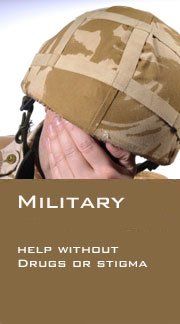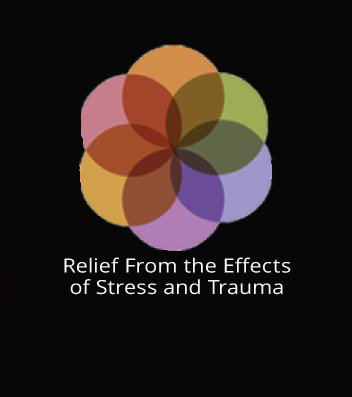Military
Military

Helping Military Personnel and Veterans
1. Current and former military personnel
2. Open letter to people of influence
Current and former military personnel
If you are suffering from the symptoms of PTSD or TBI, please take the time to review those sections on this website. Be sure to see the CASE REPORTS
at the end of each section to get a sense of just how much you might benefit from Fight or Flight Therapy.
Contrary to popular belief, many of the symptoms of PTSD and TBI often have less to do with the specifics of your traumas, and much more to do with how your nervous system responded to those traumas.
Fight-or-flight is your normal physiological response to stress. As such, we are working with your physiology, not your psychology. In Fight or Flight Therapy
we don't have to relive or even discuss your traumas. You don't even need to know what your traumas are.
Think of Fight or Flight Therapy
as a tune up for your nervous system. We are just resetting your nervous system to a calmer place.
• No drugs
• No talk therapy or emotional work
• No re-living old traumas
• No behavior modification
• No stigma
In Fight or Flight Therapy
we measure how much your nervous system has shifted into a constant state of fight-or-flight, and then we use specific wavelengths of light to gently shift it back toward normal. It's that simple, and people's lives change.
Fight or Flight Therapy should be an integral part of any stress or trauma treatment regimen. For some it's a foundational catalyst for healing, complementing other modalities. For others, it's the only therapy they need.
For more: What is Fight or Flight Therapy?
The Fight or Flight Questionnaire
Is Fight or Flight Therapy
right for you? These are a sampling of the symptoms common to people stuck in fight-or-flight.
What's your score?
You might be surprised, or maybe just confirm what you already suspect.
Open Letter
to: PEOPLE OF INFLUENCE IN THE MILITARY
and THOSE WISHING TO SUPPORT OUR VETERANS
Subject: Fight or Flight Therapy for the treatment of PTSD and TBI
Purpose
The purpose of this letter is to introduce you to the success Dr. Tessler is having with PTSD and TBI cases, and explore the avenues necessary to bring this gratifying work to a population who could most benefit: our military personnel.
Synopsis
Dr.Tessler claims to have developed a modality that could benefit tens, if not hundreds, of thousands of military personnel dealing with the effects of PTSD and TBI.
1. The methodology takes a completely new approach that has been totally overlooked by current conventional and non-traditional therapies.
2. It is short term, inexpensive, and requires a minimum of trained personnel to administer.
3. It can serve as a stand-alone treatment for some and, when used in conjunction with other modalities, it has proven to act as a complement and catalyst, often reducing the course, and/or enhancing the beneficial effects, of those other therapies.
4. Early intervention using this modality has been shown to have the potential to minimize the ultimate extent of symptomology. There is a potential to take full advantage of this in the field with simple intervention by non-trained personnel.
5. At the other end of the spectrum, treatment has been shown to be highly effective years, and even decades, after the precipitating event(s).
6. Prevention: this methodology provides the potential to predict those at risk, and the opportunity to pre-treat in order to lessen vulnerability.
Introduction
Dear Sir/Madam:
I'd like to introduce you to Fight or Flight Therapy, which has evolved over the past 18 years into the most rewarding and gratifying work I have ever done. People's lives change.
Of interest to you is what I routinely see in my practice: significant and often times dramatic success with PTSD and TBI not seen with other therapies. This includes success with clients who over many years have explored the full gamut of traditional and non-traditional therapies, with limited success.
In addition to the methodology, two things make this approach unique and help explain its unusual effectiveness. First, it is not a psychological approach. It is a physiological one, with objective empirical measures. Second, it does not treat or mask or desensitize symptoms. Instead, it directly treats the underlying cause or mechanism of those symptoms, leading to better and longer lasting outcomes.
Traumatized people often seek a wide variety of practitioners and modalities to treat, what can sometimes be, a myriad of seemingly unrelated symptoms. What if many of these seemingly disparate symptoms were all mediated by the same process? What if there was just one 'switch' you could throw to minimize or eliminate symptoms as diverse as, to name just a few: stress, anxiety, depression, anger, fear, problems with concentration, mental clarity and orientation, pain, defensiveness, irritability and sleep problems?
And, what if throwing that switch was, in most instances, a relatively easy thing to do? In my experience, Fight or Flight Therapy
is the first therapy to directly address the underlying physiological mechanism that mediates a wide variety of symptoms that can manifest from stress and/or trauma: the fight-or-flight response.
It is my clinical experience that focusing on calming the fight-or-flight
response promises to be a dynamic piece of the military's PTSD and TBI puzzle. I would expect this innovative therapy to have huge potential for improving the quality of life of our service men and women suffering from the ill-effects of stress and trauma.
The Potential...
Fight or Flight Therapy
offers:
1. a new short-term treatment option that is fast, effective, inexpensive, non-drug,
non-retraumatizing, long-lasting and requiring little or no ongoing maintenance,
2. simple inexpensive objective testing that, not only serves as an excellent measure of pre- and post-treatment status and progress made, but also of initial potential risk,
3. a treatment option that can be used preventively prior to exposure, offering the potential to reduce ultimate risk and injury, and
4. a treatment option that could eventually be administered immediately in the field by minimally-trained personnel, potentially limiting the post-trauma sequela.
It is commonly reported by the military itself that 20% of returning troops have legitimate problems relating to PTSD or TBI. Due to stigma and under-reporting, I would expect this estimate to fall well short of the true number.
According to statements by military officials, and my conversations with veterans' advocates, current interventions are time consuming, require highly trained professionals, and rely heavily on medications with their inherent shortcomings. Due to costs and personnel requirements alone, available resources will not provide comprehensive treatment for the many. Questions will continually be raised as to whether all those who could benefit from treatment have access to it, and if so, if that treatment is minimally sufficient.
Fight or Flight Therapy
offers an opportunity to treat literally thousands of individuals with an economy of time, dollars and personnel. Its very nature, being a non-psychological approach, allows it to be presented in such a way as to eliminate any stigma whatsoever. It could easily and honestly be presented and languaged in terms of stress relief. As part of a transitional program it could easily be performed on everyone exiting the service.
Ultimately, it affords us the opportunity to help protect and honor many more of our suffering heroes.
In Conclusion
Can we agree that the considerable potential this innovative modality affords should not be ignored?
If so, how do we expeditiously fast-track whatever testing and validation is required to meet the military's due diligence for standard of care?
And ultimately, how can we make this exciting preventive and therapeutic option more widely available to fully realize its potential to change, and even save, lives?
I welcome your insights and suggestions.
Sincerely,
M. Stuart Tessler, OD, FCSO
The Fight or Flight
Questionaire
Is Flight or Flight Therapy right for you?
These area a sampling of symptoms common to people stuck in fight-or-flight.
How many symptoms do you have?
You might be surprised, or maybe you will confirm what you already suspect.
How many symptoms do you have?
You might be surprised, or maybe you will confirm what you already suspect.

